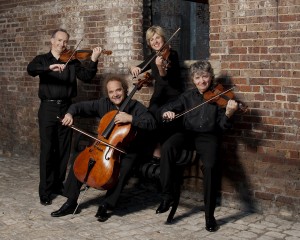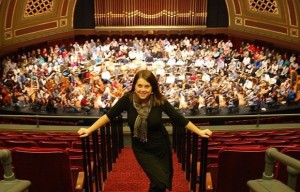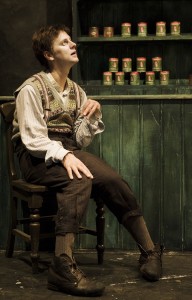UMS Connect: Takács Quartet with Julien Labro
Welcome to UMS Connect, a new digital series that invites audiences to dive deeper into the season’s performances in casual conversations with artists and creators.

In our two-part debut episode of UMS Connect, we explore the upcoming program by the Takács Quartet and bandoneón virtuoso Julien Labro, which features two world premieres and UMS co-commissioned works by composers Clarice Assad and Bryce Dessner. Enjoy learning more about the quartet’s 35+ year history performing with UMS, and what makes this unique collaboration so meaningful as these artists join forces for the first time.
Part 1
Michael Kondziolka, UMS’s VP of Programming and Production, introduces Takács Quartet members Harumi Rhodes and Ed Dusinberre in a discussion about the process of learning new works with bandoneón virtuoso Julien Labro. Julien then joins Ed and Harumi to reflect on the new sonic world they discovered upon their first rehearsals coming out of the pandemic.
Part 2
Mark Jacobson, UMS’s senior programming manager, joins Julien Labro for an extended discussion of the works performed, and a demonstration of the bandoneón and the members of the accordion family.
Listen: Exploring Beethoven’s String Quartets with Stephen Whiting
Takács Quartet performs the complete Beethoven Quartet Cycle during the 2016-17 at UMS, a tour in conjunction with the release of Dusinberre’s new book Beethoven for a Later Age: The Journey of a String Quartet.
In conjunction with these performances, U-M Professor of Musicology Steven Whiting gives a series of lectures that explore Beethoven’s String Quartets. Recordings of these lectures will be available on this page.
Part 1:
Part 1 text excerpt. Listen above for full lecture.
Caution is not a word we ordinarily associate with Ludwig van Beethoven, yet he was cautious about engaging a genre associated by Viennese music lovers with his erstwhile teacher Joseph Haydn. Haydn had been the acknowledged master of the string quartet for decades. His works, above all others, had so raised the aesthetic stock of the genre that by 1800 the string quartet was regarded as the highest, noblest, most intellectual kind of chamber music. To paraphrase Goethe, a kind of idealized conversation between four equally intelligent and witty partners.
All through the 1790s, Beethoven studied model quartets by Haydn and Mozart after writing them out in score, because back then, quartets were only published in parts. Not until 1798 did he feel ready to enter the lists with his former master. He accepted a commission from the young Bohemian prince Lobkowitz for a half-dozen string quartets. Cheaper by the half-dozen. The same commission went out to Haydn. Vienna, you must know, invested in music the sort of cultural energy we invest in football. Is somebody keeping track of the score? Haydn was only able to complete the two quartets, later published as Opus 77. Beethoven’s first bundle of six was published as his Opus 18 in the summer of 1801. They served notice on the musical world that Beethoven was more than the latest hot piano virtuoso. He did not return to quartet writing until 1806, after he had revised his opera Leonore, a.k.a. Fidelio, unsuccessfully, as it turned out.
He set to work on a bundle of three quartets, apparently at the behest of Count Razumovsky, the Russian ambassador to the Habsburg court. I say apparently because the commission itself does no longer survive, nor is there any documentation of Razumovsky’s having asked Beethoven to work two or more Russian folk melodies into these quartets. It may have been Beethoven’s idea of a compliment. By common consensus, Opus 59 took the quartet out of the realm of private music-making by skilled amateurs and into the realm of public concertizing by professionals, because the music was just too darn hard for amateurs to play anymore. They are as massively scaled, in comparison with Opus 18, as the Eroica seems in comparison with the first two symphonies or Waldstein and Pathétique seem in comparison with earlier sonatas for piano solo.
Yet, Beethoven always frustrates listeners who grasp artistic development in terms of straight-line evolution. His next string quartet, composed during the French occupation of Vienna in summer 1809, and published as Opus 74, betrays far less symphonic ambition than Opus 59. It returns to the proportions of Haydn and some of the strategies. I am not the first to suspect that this quartet is Beethoven’s homage, and even eulogy, to Haydn, who died in May that year. You’ll hear it this weekend, and you’ll hear its even denser, more compact successor, the F minor Quartetto serioso, composed in 1810. For once, yes, the nickname derives from the composer. The high Opus number, 95, is explained by the delay in its publication until 1816. It is still a middle period work, albeit a thoroughly bewildering one. Then come the five quartets of Beethoven’s third, or late, period.
Continue listening to full lecture via video above.
Takács Quartet performs January 21-22, March 25-26, 2017 in Ann Arbor.
Artist Interview: Takács Quartet Violinist Ed Dusinberre
On October 6, 2016, Takács Quartet volinist Ed Dusinberre was interviewed by U-M Professor of Musicology Steve Whiting at Literati Bookstore in Ann Arbor.
Takács Quartet performs the complete Beethoven Quartet Cycle during the 2016-17 at UMS, a tour in conjunction with the release of Dusinberre’s new book Beethoven for a Later Age: The Journey of a String Quartet.
Takács Quartet performs October 8-9, 2016 and January 21-22, March 25-26, 2017 in Ann Arbor.
Why are Beethoven’s String Quartets widely regarded as his “greatest compositions”?
As a French horn performance major at the University of Michigan, I’ve been immersed in chamber music of all stripes, from classical duos to contemporary dectets. At U-M, my (brass and woodwind) colleagues and I strayed away from playing music of Beethoven, Haydn and Mozart in our chamber groups, while other (string) chamber groups played only that music. How can they play Beethoven’s music all the time?, I’d think to myself. Doesn’t it get boring? After four years of wondering, I’ve finally discovered that the answer to that question is “no”, and here’s why.
Beethoven was arguably the most critical figure in creating the movement from the classical era to the romantic era. Take a listen and you’ll see that his string quartets are easily the most intimate of his works. That’s because they involve only four voices, each with its own personality. For audience members, Beethoven’s string quartets are a keyhole to Beethoven’s genius during some of his most vulnerable times.
Beethoven took the string quartet to the next level, a level, perhaps, too high for many people of his time. While his predecessors like Mozart and Haydn wrote incredible string quartets as well, Beethoven had something new and exciting to offer in his string quartets. He added a new depth, variation, and complexity. Beethoven’s string quartets are often regarded as “characteristically unique.”
“They are not for you, but for a later age!” So wrote Ludwig van Beethoven about his Op. 59 quartets, which will be performed in Ann Arbor as part of a complete Beethoven string quartet cycle by the Takács Quartet over six concerts (three weekends) in the 2016-17 season.
Beethoven’s quartets are divided into three periods: early, middle, and late. His early quartets, nos. 1-6, are said to be reminiscent of Haydn and Mozart. The first three (nos. 7-9) of his middle quartets (nos. 7-11) are nick-named the Razumovsky quartets, as Count Razumovsky commissioned them. Beethoven’s sad and dismal last few years of life are well-reflected in his late quartets, nos. 12-16. Take a listen to the beginning of nos. 12-15 and you’ll hear that each has a slow, chorale-like opening, not something we hear in the openings of Beethoven’s early and middle quartets.
As I’m writing this blog post, I’m listening to all of Beethoven’s string quartets. For me, what’s prominent in each is genuine emotion. There are also dynamic contrasts that are characteristic of Beethoven’s symphonies. Each of his string quartets sound almost like mini-operas.
Take a listen to the fourth movement of Beethoven’s Quartet in B-flat Major, no. 6 – op. 18. The first section is marked as “La Melancholia Adagio” (played at a melancholy, slow tempo) and within the same movement, the second section is marked “Allegretto quasi Allegro” (played at a quicker tempo in a lighter, more dance-like manner). Within just one movement of one of Beethoven’s quartets, we experience two polar opposite tempos, styles, and emotions.
Here’s a special challenge for you: Try listening to the Takacs Quartet’s recording of Quartet in B flat major – op. 130, movement 5 without shedding a tear. I will say that, as a brass player, sometimes I can’t stay engaged when listening to string music, but the musical genius and emotion that Beethoven poured into his string quartets is impossible for me to ignore.
But what else makes these quartets so impossible to ignore? And what else goes into making these quartets so highly regarded as Beethoven’s best works? The musicians that play them, of course!
How do today’s musicians do justice to Beethoven’s String Quartets?
In the TEDx Talk above, Edward Dusinberre, first violinist of the Takacs Quartet, says that the primary goal of the Takacs Quartet is to “try to communicate a very strong musical character.”
While Beethoven may give hints by writing “specific character instructions” (as Dusinberre calls them), it’s up to the musician to interpret those instructions. Dusinberre mentions that the quartet must work individually and as a group to discover what style works best in effectively communicating a specific character instruction written at the beginning of the piece. This can be done by changing the timbre, articulation, dynamics, tempo, and musical phrasing.
There are only four voices in a string quartet. So, there are only four musicians, which adds to the intimacy of Beethoven’s string quartets.
But passion is what fuels the performance of the Beethoven String Quartet cycle, the same passion that fuels Beethoven’s writing of the piece. Through style, passion and communication, Beethoven’s string quartets are kept alive today.
The Takacs Quartet has released several albums and recordings of high merit, but the albums that have received the most recognition are their Beethoven String Quartet albums. These albums (one of which was awarded the 2002 GRAMMY for best chamber music recording) have received numerous awards and are highly praised.
Edward Dusinberre’s book, Beethoven for a Later Age: Journey of a String Quartet gives readers insider information on the journey of the Takacs Quartet as well as the journey of Beethoven’s composing his string quartets.
So, the answer is “no.” Beethoven’s music does not get boring for string chamber musicians, because they have learned to enjoy the process of bringing his music to life. As a musician, I am privileged enough to be able to musically tell a story. Beethoven’s string quartets and the Takacs Quartet have taught me — a brass player! — that the key to successfully telling the story is to engage the audience by communicating with them through my musical styles and through my passion.
Ann Arbor audiences can expect to experience this artist-to-audience connection during the Takacs Quartet’s performances of the Beethoven String Quartet cycle with UMS for the 2016-2017 season. As Dusinberre said, “The performance can create an atmosphere on stage where the audience doesn’t feel inhibited [to express themselves]”, an atmosphere that the Takacs Quartet is sure to bring to Ann Arbor.
The Perpetually Classical String Quartet

On left, Takács Quartet, and on right, Danish String Quartet. Photos by Ellen Appel and Caroline Bittencourt.
Later this fall, UMS will present performances by two renowned string quartets. In November, the upstart Danish Quartet will make their UMS debut, and the next month will see the return of the much-beloved Takács Quartet, who last performed to Ann Arbor audiences in April, 2013.
Both groups are presenting remarkably similar programs. Each will open with a Haydn quartet (both in C major, no less!), then perform quartet written in the last twenty years, and close with a Romantic quartet: Beethoven for Danish Quartet, and Dvořák for Takács. I have written previously about the way programs like these, which juxtapose older and newer string quartet compositions, demonstrate the history of the genre, namely the changes string quartet music has undergone from the Classical era to today and the recent past. At the risk of contradicting myself, I think the Danish and Takács Quartet’s programs more aptly demonstrate the way string quartet music has not changed over time. Truthfully, this kind of continuity is always present in string quartet music because the ensemble has not changed at all since Haydn wrote his first quartet in the 1760s.
Two violins, a viola, and a cello
By contrast, composers, from Beethoven to the students in the University of Michigan’s music composition department, constantly tinker with the orchestra to create different, seemingly new, sounds. Even the piano continued to evolve, mechanically speaking, throughout the eighteenth, nineteenth, and twentieth centuries. But, the string quartet has consisted of two violins, a viola, and a cello for over 250 years – it may be a perpetually Classical ensemble. Obviously, nineteenth, twentieth, and twenty-first century composers have stretched the sonic envelope of string quartet music to incredible lengths.
Black Angels by George Crumb
Devoted patrons of UMS’s Chamber Arts Series may remember the Kronos Quartet’s two performances from January 2014, when they performed, among other works, George Crumb’s Black Angels. Here, Crumb amplifies the quartet and asks its performers to yell and play various percussion instruments. This may seem like an irrevocable departure from the traditional corpus of string quartet music, but that is not the case. One of Black Angels’ more subdued movements features a heartbreaking quotation from Schubert’s String Quartet No. 14, “Death and the Maiden” – despite the experimental daring of Crumb’s sound world, Black Angels still contains a vibrant connection to the string quartet’s Classical heritage.
Arcadiana by Thomas Adés
Thomas Adés and Timo Andres, the living composers who will be performed by the Danish and Takács String Quartets, also maintain an awareness of the past in their music. Adés’ quartet Arcadiana, which appears on the Danish String Quartet’s program, features a potent allusion to one of Franz Schubert’s celebrated art songs, Auf dem wasser zu singen. Here, Adés interpolates quotations from Schubert’s song with his own musical material in a manner that contemplates what Adés observes as the most important theme of the original song’s texts: vanishing time. Accordingly, this movement of Arcadiana is strikingly characterizes by the sense of temporal unevenness; the quartet’s members do not wholly come together until the beginning of the subsequent movement. Although it has seven labeled movements, Arcadiana is composed very fluidly, and typically performed so that each section into the next without interruption. Similarly, though “Auf dem wasser zu singen” is the only part of Arcadiana to make an explicit reference to nineteenth century music, the rest of the work clearly expresses a kind of refracted anachronism that draws heavily on traditional compositional precedents. Much of the work is typified by active gestures and fleeting melodic and harmonic ideas, except for the penultimate movement, “O Albion”, which is a stunningly simple and beautiful statement in counterpoint.
An interview with Timo Andres
Timo Andres’ Strong Language, which will be played in between Haydn and Beethoven on the Takács Quartet’s December program, is more of a mystery because it has not yet received its premiere performance. However, Andres discusses the work at length on his website, describing it as an exercise in musical economy: “Strong Language has three movements and exactly three musical ideas.” Andres is also a renowned pianist, who frequently performs standard repertoire alongside his own compositions and those of other living composers. Thus, it seems likely this new work for string quartet will possess some kind of grounding in Classical music’s tradition. Certainly, this is the case in Andres’ last quartet, Early to Rise (2013), which, like Arcadiana, makes allusions to nineteenth century German art song (though, Andres’ work references Schumann, not Schubert). Per Andres’ description, Strong Language indeed seems to embrace numerous traditional compositional techniques, though its final movement features atypical instrumental sounds, such as scrapes and knocking.
Nevertheless, it is likely Strong Language, just like Arcadiana, will provide further evidence that the string quartet, as a genre and ensemble, is perpetually Classical. Even the purported noise elements in Strong Language’s closing movement are nothing new – George Crumb’s aforementioned Black Angels features similar effects and is forty-five years old.
Of course, the consistency in the string quartet and its repertoire I point out here does not represent a weakness for the ensemble, but, rather, an incredible strength. To support the expression of so many different composers over 250 years of Western musical history with the same instrumentation tells us a great deal about the enormous value of the string quartet as a medium. Be sure to consider the enduring strength of this musical tradition when it is on full display in the surely masterful performances the Danish String Quartet and Takács Quartet will share with UMS audiences in November and December.
The Danish String Quartet performs on November 6, 2015, and the Takács String Quartet returns on December 6, 2015.
Interested in more? Garrett Schumann is a regular contributor to UMS Lobby.
Behind the Scenes with Takács Quartet
During the 2016-17 season, the Takács Quartet performs the complete cycle in only four venues worldwide, coinciding with the release of a book by Takács first violinist Edward Dusinberre, Beethoven for a Later Age: The Journey of a String Quartet. The book explores the inner life of a string quartet, melding music history and memoir as it explores the circumstances surrounding the composition of Beethoven’s quartets.
In 2013, we interviewed Dusinberre about putting together a performance program:
Last updated 4/29/2016.
Tracing the String Quartet

Photo: Takács Quartet performs. Photo courtesy of Frank Stewart /Savannah Music Festival via npr.org.
Like the Mass, Opera and the Symphony, music for String Quartet is one of the most enduring genres in Classical Music. Since the genre’s emergence at the end of the eighteenth century to the present, generation after generation of composers have found this grouping of a cello, viola and two violins, inexhaustibly fascinating. Although there are a few notable exceptions, nearly every composer from Haydn to the present day has used this genre as a place for growth, experimentation and, above all, individual expression. Armed with its deceptively simple instrumentation, the String Quartet is capable of achieving an enormous range of textures, colors and moods, a generous sampling of which will be on tap at the April 12 performance by the world-renowned Takács Quartet.
The evening’s program begins with a representative work by the father of the String Quartet, Joseph Haydn, who, arguably, invented the genre out of necessity while working at the country estate of Baron Carl von Joseph Edler von Fürnberg. The ‘Sunrise’ Quartet displays the foundational form for String Quartets in the Classical Period, which was borrowed from symphonic music. The first and last movements are fast, and intervening are a slow second movement and a minuet, or, sometimes, a scherzo, which feature lighter fast music than the outer movements. Beethoven, who studied with Haydn, continued this formalism in his charming early quartets, but by they time we get to the Quartet no. 14 in c-sharp Minor, we encounter a work that is much longer and more formally diverse than its predecessors in the genre.
Dating from the final period in Beethoven’s life, the Quartet no. 14 is a leviathan and explosive gesture of Romanticism. Although this might seem hard to believe to a contemporary audience, most of Beethoven’s late works, including this quartet, were considered wildly and undesirably avant-garde. The Quartet no. 14 breaks the rules by possessing an unprecedented structural circularity, which means the audience should consider the piece as one large musical idea, instead of a series of smaller, separate gestures grouped together under one title. This continuity is built into the performance of the Quartet no. 14, because its seven movements are played without breaks between them.
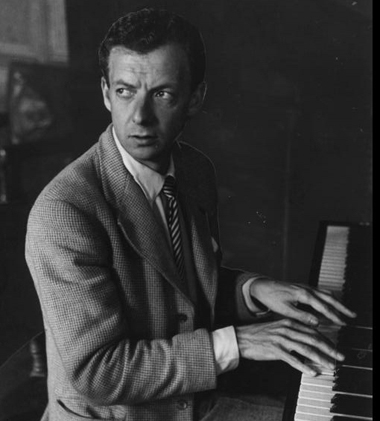
Benjamin Britten
If Beethoven’s Quartet no. 14 represents the genre’s ability to portray a composer’s idiosyncrasy, and Haydn’s ‘Sunrise’ Quartet represents String Quartet music’s formal origins, then Benjamin Britten’s String Quartet no. 3 in G major, proffers one example of how later composers balanced these seminal elements. The work uses a broad range of textures and colors, which harkens to the diverse material of the Beethoven, though String Quartet no. 3’s five movements are decidedly unrelated, which is more in tune with Haydn’s Classical Period quartets. Britten died two weeks before the String Quartet no. 3 was premiered, but the piece is not a personal requiem, despite its many haunting and beautiful passages. Nevertheless, the work is a culminating example of Britten’s music, not to mention more modern composers’ contributions to the long line of works written for String Quartet.
Garrett Schumann is a regular contributor to UMS Lobby. Read his other commentary.
Video: Edward Dusinberre of the Takács Quartet on Playing in Ann Arbor (Part 1)
Last season, UMS Director of Programming Michael Kondziolka had the chance to sit down with Edward Dusinberre, violinist of the Takács Quartet, to talk about what it’s like to play for the Ann Arbor audience, why Ann Arbor audiences are special, and how the adrenaline always rushes before an Ann Arbor performance. Above is part one of the two part interview.
UMS Staff Picks: Takács Quartet selected by Liz Stover, Programming Coordinator
SN: The Takács Quartet has been treating UMS audiences to exceptional performances of chamber works for many years, but in the 10/11 season, there will be not one, but three very special opportunities to hear this quartet as they perform their Schubert Project cycle of concerts. What will be unique and memorable about each of these performances?
LS: It’s not every year that you get to hear so much of a single composer’s work in the span of a season, so I am thrilled for the opportunity to focus some attention on Schubert. While there’s not nearly enough time to hear all of his chamber music, we’ll hear some of my favorites: D.810 (“Death and the Maiden”), the “Trout” Piano Quintet, and the Cello Quintet! We’ve heard the Takács Quartet perform many times here in Ann Arbor (12, to be exact), but I’m also excited to hear them collaborate with other notable musicians: pianist Jeffrey Kahane (who is also music director of the Los Angeles Chamber Orchestra and Colorado Symphony), bassist John Feeney (principal bass of the Orchestra of St. Luke’s in New York), and cellist Paul Katz (who performed here three times as cellist of the Cleveland Quartet).
SN: Have you seen a performance by the Takács Quartet before?
LS: Yes. I saw them the last two times they were here, in March 2010 and April 2009, and I think in January 2007, too. I loved their April 2009 performance with Marc-André Hamelin when they performed the Schumann Piano Quintet. The first time I ever played chamber music for fun was with a piano quintet (though we played Brahms) so I really enjoy hearing that repertoire. It makes me think back to how challenging it was for me and how much I learned as a musician from playing in a small group rather than an orchestra.
SN: What are you most looking forward to about this series of performances?
LS: To begin with, I just love Schubert…his compositions can be so heartbreakingly romantic. Did you hear David Finckel, Wu Han, and Philip Setzer play the piano trios in February? There wasn’t a dull moment in that concert—it was a highlight of the season for me. As I mentioned before, it’s really exciting to hear so much of one composer’s work in one season, and this series of concerts lines up with a personal goal to build my knowledge of classical repertoire. I also share a love for chamber music (and Schubert) with my boyfriend Zack, who is a violist, so I’m looking forward to experiencing the concerts together.
SN: What other events are on your “must see” list for the 10/11 season?
LS: Mahler’s Fifth Symphony is one of the very reasons I work at UMS (hearing it performed by the New York Philharmonic in February 2005 made me instantly apply to become a UMS intern as a student) so I can’t wait to hear it again by the Mariinsky Orchestra. I’m also really excited about our collaboration with the Detroit Symphony Orchestra and Michigan Opera Theater to present Mahler’s Eighth Symphony. It’s a once-(or very few) in-a-lifetime opportunity to hear it performed and I’m excited to be involved in the production of that event. I’ve also become a huge dance lover over the past few years, so I’m looking forward to seeing all of the companies on our season—all are new to me! I also won’t miss Stew and the Negro Problem, Carolina Chocolate Drops, and Druid’s production of The Cripple of Inishmaan.
SN: What do you enjoy doing outside of work?
LS: Knitting! Almost two years ago, I began knitting seriously, and I have fallen in love with it! It’s a wonderful stress reliever and I just love the feeling of producing something. I’m currently working on a cardigan. I’ve even taught a few friends and coworkers to knit and it’s so exciting to see them producing beautiful garments. Besides that, I enjoy watching baseball (my boyfriend has turned me into a Red Sox fan), traveling, and spending time with friends and family (including my two dogs, Rumor and Gypsy, who live with my parents in the DC area). I’m also hoping to take my violin out soon and start playing more regularly as it’s been in my closet for the last year—I’m sure these concerts will inspire me to do so!
SN: What have you been listening to on your iPod?
LS: Since we presented Punch Brothers at the Power Center last summer, I have not been able to stop listening to them! Their CDs Punch and Antifogmatic are in very frequent rotation as well as some of their earlier work under Chris Thile’s name. I have also recently taken up spinning at the Y, and Lady Gaga helps me get through a solid hour of exercise. Other favorites include Broken Bells, Dave Matthews Band, Ingrid Michaelson, and Wilco. When it comes to classical music, Mahler and Rachmaninoff are two of my favorite composers, so this season’s repertoire is especially exciting for me!
UMS Staff Picks: The Cripple of Inishmaan selected by Sara Billmann, Director of Marketing & Communications
SN: The multi-award winning Druid and Atlantic Theater co-production of Martin McDonagh’s The Cripple of Inishmaan has been described as “a break-your-heart, cruelly funny evening” – what kind of theatrical journey can audience members expect to experience when they see this production?
SB: I don’t want to spoil the story, but suffice it to say that it will be quite an emotional ride.
I’ve seen two of Martin McDonagh’s plays when they were produced in New York in the mid-late 1990s, and they are simply brilliant pieces, in part because of the way they force you to re-examine your own morals. He sets up these outrageous scenes that are absolutely hilarious, then delivers the knock-out punch that makes you realize you’ve been laughing at something that is, in fact, incredibly tragic. The June issue of <i>Opera News</i> put it perfectly: “As anyone who’s ever sat through a Martin McDonagh play can attest, sometimes the only response we can muster when confronted with the searing emotional or physical pain of others is a laugh.”
I read this play poolside while visiting my in-laws in San Antonio and found myself laughing out loud on any number of occasions. Let’s face it, there are many plays where you chuckle inwardly, but something that produces a spontaneous outburst while reading to yourself is extraordinary in its own sense. And based on every production I’ve seen of McDonagh’s work, the live production will far exceed what’s on the page.
So that we could all familiarize ourselves with the play, about a dozen members of the UMS staff did a “read-through” this summer. I hope that some audience members will be interested in doing the same — we’d be interested in putting together play-reading groups for others and loaning the scripts. It’s a great way to familiarize yourself with the dialects and turns of language that really bring the piece alive. And, of course, a great way to meet new people too.
SN: What are you most looking forward to about this UMS debut performance?
SB: It’s pretty simple, really – I just can’t wait to see what they do with the production to bring it alive. I have friends who saw this production when it was on Broadway a few years ago and raved about it. Having grown up in a small town, I recognize some of the quirky characters and look forward to seeing how they are realized on stage.
SN: What other events are on your “must see” list for the 10/11 season?
SB: Just about everything! As a trained classical musician, I’m particularly interested in the big orchestras and piano recitals. I was turned on to Denis Matsuev about two years ago by someone who had heard his recording in Gramophone magazine. His playing is really quite extraordinary. I also adore Schubert and am looking forward to the three Tákacs concerts, as well as the Scharoun Ensemble performance of the Schubert Octet. I’m also looking forward to Grupo Corpo – what a great company! I could go on and on. The beauty of being the marketing director for UMS is that I start to research all of the artists we’re presenting long before we announce the season, and I always get turned on to things I never would have thought I’d enjoy…which ultimately means that the entire season becomes a “must see” for me.
SN: What do you enjoy doing outside of work?
SB: I have two kids – Elisabeth is 8 and going into 4th grade, and Harry is 6 and going into 1st grade – who keep me plenty busy. I was about to respond that I do laundry outside of work, until I saw the word “enjoy” in the question. Elisabeth loves to play baseball, so I think I’ve spent the better part of July attending her games and taking her to see the Tigers when time permits. I’m also hopelessly addicted to The New Yorker and steal moments here and there to try to stay caught up. Other hobbies include wine tasting and walking the dog – we acquired a boxer/pointer mix from the Humane Society three months ago, and I’ve become the family’s designated dog walker, which fills up a shocking amount of time each day.
SN: What have you been listening to on your iPod?
SB: Ha! The day I get to listen to my iPod will be a great day indeed. Lately my kids have been torturing me, making me listen to “Stayin’ Alive” and 1980s dance tunes (oh, to return to the days when my daughter would watch “The Barber of Seville” by choice…). But when I can wrestle it away from them, I mostly listen to Schubert lieder, Maria Joao Pires performing Schubert and Chopin, Denis Matsuev playing Rachmaninoff, and Mahler, though truth be told, the iPod doesn’t do Mahler justice. Murray Perahia‘s recital in 2000 of the Bach/Busoni Chorale Preludes and the Goldberg Variations will always rank among my top UMS performances, and I often bring back that memory with the recording “Songs Without Words” released around the same time. Angelika Kirchschlager and Fritz Wunderlich are among my favorite singers, though I will confess that I also enjoy Pink Martini in my less serious moments. And I recently loaded on a CD by a wonderful Iranian group called Ghazal.
10/11 Chamber Arts Series & Schubertiade Announced
The 48th Annual UMS Chamber Arts Series presents some of today’s leading chamber musicians performing both traditional and contemporary repertoire:
Schubert Cycle Concert 1
Takács Quartet
Jeffrey Kahane, piano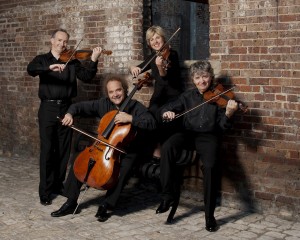
Thursday, October 14 | 8 pm
Rackham Auditorium
The always superlative Takács Quartet has become an Ann Arbor favorite over the past decade, consistently delivering performances that live well beyond the last note played in the concert hall. In the 10/11 season, they perform a three-concert cycle of Schubert’s quartets and quintets, with the first performance launching the Chamber Arts Series. Commenting on their latest Schubert recording for Hyperion, Gramophone magazine noted, “The Takács have the ability to make you believe that there’s no other possible way the music should go, and the strength to overturn preconceptions that comes with only the greatest performers.” This first concert features pianist Jeffrey Kahane, and balances two Schubert string quartets with the young American composer Daniel Kellogg’s Variations on “Death and the Maiden.”
Program
Schubert String Quartet in E-flat Major, D. 87
Schubert Piano Sonata in B-flat Major, D. 960 (Op. Post.)
Daniel Kellogg Variations on a Theme from “Death and the Maiden”
Schubert String Quartet in d minor, D. 810
Jerusalem Quartet
Thursday, October 21 | 8 pm
Rackham Auditorium
“Superlatives are inadequate in describing just how this playing was from one of the young, yet great, quartets of our time.” (The Strad) Returning after its widely acclaimed UMS visit in 2007, the Jerusalem Quartet was formed in 1993, when its members were still teenagers, within the framework of the Young Musicians’ Group under the auspices of the Jerusalem Music Centre and the America Israel Cultural Foundation. “Musical electricity may be unfathomable, but one thing is for sure — they have it.” (The Strad)
Program
Mendelssohn Quartet in e minor, Op. 44, No. 2
Mark Kopytman String Quartet No. 3 (1969)
Brahms Quartet in c minor, Op. 51, No. 1
The Historic Concert
ONCE.MORE Festival:
A 50th Anniversary Moment
Tuesday, November 2 | 8 pm
Rackham Auditorium
The ONCE Group was a collection of musicians, visual artists, architects, and film-makers who wished to create an environment in which artists could explore and share techniques and ideas in the late 1950s and early 1960s. The group hosted the ONCE Festival six times in Ann Arbor in the early 1960s; one of the enduring outcomes of this group is the Ann Arbor Film Festival. The organizers of the ONCE festival were five composition students of U-M composition professor Ross Lee Finney, whose sabbatical in Europe resulted in a revolution of sorts among his students, who began using electronics in their compositions. This concert represents the historic works presented during Ann Arbor’s ONCE Festival some 50 years ago; a second concert, presented two days later (and not on the Chamber Arts Series), will look at more recent works by the same composers. This special collaboration with the U-M School of Music, Theatre & Dance will provide a look into Ann Arbor’s progressive role in the development of avant-garde music.
Program
Roger Reynolds Mosaic for Flute and Piano (1962)
Robert Ashley in memoriam…Crazy Horse (1963)
Gordon Mumma Large Size Mograph (1962)
Donald Scavarda Group for Piano (1959)
Robert Ashley in memoriam…Esteban Gomez (1963)
Donald Scavarda FilmSCORE for Two Pianists (1962)
Donald Scavarda GREYS, A FilmSCORE (silent version) (1963)
Scavarda/Mumma GREYS, A FilmSCORE (with sound) (1963)
Gordon Mumma Sinfonia (1958-60)
Donald Scavarda Matrix for Clarinetist (1962)
Roger Reynolds A Portrait of Vanzetti (1962-63)
Nadja Salerno-Sonnenberg, violin
New Century Chamber Orchestra
Friday, February 4 | 8 pm
Rackham Auditorium
Electrifying performances, fearless interpretations, and musical depth have established the violinist Nadja Salerno-Sonnenberg as one of the leading violinists of our time. She was born in Rome and immigrated to the United States at the age of eight to study at The Curtis Institute of Music, beginning her professional career in 1981 when she became the youngest person ever to win the Walter W. Naumburg International Violin Competition. For the past two years, she has served as music director of San Francisco’s New Century Chamber Orchestra, which makes its UMS debut with a program that includes Astor Piazzolla’s Four Seasons of Buenos Aires, a tango-inspired version that complements the Vivaldi and Philip Glass “Four Seasons” on the Choral Union Series.
Program
Wolf/arr. Drew Italian Serenade (1887)
Bartók/Willner Romanian Folk Dances
Piazzolla Four Seasons of Buenos Aires (1964-70)
Tchaikovsky Serenade for Strings in C Major, Op. 48
Concertante and Rafał Blechacz, piano
Sunday, February 13 | 4 pm
Rackham Auditorium
Comprised of a core of six virtuoso string players, Concertante performs in varied combinations of instrumentalists with a sheen, warmth, and polish that are the hallmark of superb chamber music groups. For this concert, they are joined the Polish pianist Rafał Blechacz, who performs in recital on the Choral Union Series two nights earlier, for a chamber arrangement of Chopin’s Piano Concerto No. 1, written when the composer was only 20 years old. Blechacz is widely regarded as a supreme interpreter of Chopin’s works, sweeping all five first prizes at the 2005 International Chopin Competition when he was just 20, the first Pole to achieve the honor since Krystian Zimerman in 1975.
Program
Elgar Serenade for Strings in e minor, Op. 20
Schoenberg Verklärte Nacht, Op. 4
Chopin Piano Concerto No. 1 in e minor, Op. 11
Scharoun Ensemble Berlin
Chamber Musicians of the Berlin Philharmonic
Wednesday, March 9 | 8 pm
Rackham Auditorium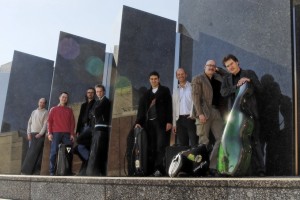
In 1983, members of the Berlin Philharmonic founded the Scharoun Ensemble Berlin, named after the architect who designed the marvelous concert hall where the Berlin Philharmonic performs at home. The eight musicians of the Scharoun Ensemble express an artistic commitment to both the heritage of the past and the challenges of the present. The ensemble comprises the standard octet instrumentation — clarinet, horn, bassoon, two violins, viola, cello, and double bass —allowing them to perform some of the great chamber music literature of Schubert, Mozart, Beethoven, and Brahms, in addition to 20th-century classical modernist works and contemporary music.
Program
Schubert Octet in F Major, D. 803
Additional works to be announced.
Tetzlaff Quartet
Saturday, April 9| 8 pm
Rackham Auditorium
The terrific German violinist Christian Tetzlaff, who most recently appeared with as soloist with the San Francisco Symphony, in addition to solo recital appearances at both St. Francis of Assisi Catholic Church and Hill Auditorium, brings his chamber ensemble, the Tetzlaff Quartet. The group was founded in 1994 by Tetzlaff and his sister, Tanja, along with two musicians with a mutual devotion to chamber music whom they met at a chamber music festival in Switzerland. Despite reduced availability, they make a commitment to perform each year as a quartet, drawing accolades from critics and casual listeners alike.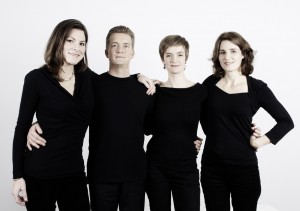
Program
Haydn Quartet in g minor, Op. 20, No. 3
Mendelssohn Quartet in a minor, Op. 13
Sibelius Quartet in d minor, Op. 56 ”Voces Intimae” (1909)
Schubertiade Series
The always superlative Takács Quartet has become an Ann Arbor favorite over the past decade, consistently delivering performances that live well beyond the last note played in the concert hall. In the 10/11 season, they perform a three-concert cycle of Schubert’s quartets and quintets (Thursday, October 14; Sunday, February 20; and Friday, April 8).
Schubert Cycle Concert 2
Takács Quartet
Sunday, February 20| 4 pm
Rackham Auditorium
Program
Schubert String Quartet in B-flat Major, D. 112
Schubert String Quartet in a minor, D. 804
Schubert String Quartet in G Major, D. 887
Schubert Cycle Concert 3
Takács Quartet
Jeffrey Kahane, piano
Paul Katz, cello
John Feeney, double bass
Friday, April 8 | 8 pm
Rackham Auditorium
Program
Schubert Piano Quintet in A Major, D. 667 (“Trout”)
Schubert Cello Quintet in C Major, D. 956
Tickets for the 7-concert series range from $124-$256. Subscription renewal packets and brochures will be mailed in early May.
An additional option that includes all three Schubert concerts by the Takács Quartet (nine concerts total) ranges from $170-$340.
Tickets to individual events on the series go on sale on Monday, August 23 (via www.ums.org) and Wednesday, August 25 (in person and by phone).
Which events in the season are you most anticipating? Let us know in the comments area below.
The always superlative Takács Quartet has become an Ann Arbor favorite over the past decade, consistently delivering performances that live well beyond the last note played in the concert hall. In the 10/11 season, they perform a three-concert cycle of Schubert’s quartets and quintets, with the first performance launching the Chamber Arts Series. Commenting on their latest Schubert recording for Hyperion, Gramophone magazine noted, “The Takács have the ability to make you believe that there’s no other possible way the music should go, and the strength to overturn preconceptions that comes with only the greatest performers.” This first concert features pianist Jeffrey Kahane, and balances two Schubert string quartets with the young American composer Daniel Kellogg’s Variations on “Death and the Maiden.”


